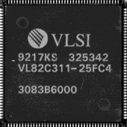 VLSI Technology, Inc.
VLSI Technology, Inc.
VLSI Technology Inc, sometimes called VTI, were a maker of custom integrated circuits (ICs) including early chipsets for 80286 and 80386 motherboard manufacturers. In the 1980s PC market, they produced integrated chipsets that went up against Chips & Technologies, Headland and Suntac. Based in Silicon Valley, VLSI created their own chip fabrication plant in San Jose, CA, and later in San Antonio, TX. After initial successes with the 286 and 386 chipsets, they dropped out of the PC market when it became clear that Intel were combining their processors, chipsets and more into a cheap package-deal for the motherboard manufacturers.
Around 1992, Intel bought 20% of the company for $50M in a deal whereby VLSI would be granted a licence to the core of the Intel 80386SL 3.3V processor to produce semi-custom integrated 386 processors targeted for the palmtop and subnotebook markets. These VLSI-designed chips would be manufactured at Intel's fabrication plants.
In 1994, they launched their "SuperCore" chipset for the Pentium 3.3V P54C processors.
VLSI Technology later focussed on audio and graphics chipsets until they were acquired by Philips in 1999.
VL82C100 / VL82C101 / VL82C102 / VL82C103 / VL82C104This was a five-chip chipset designed for 80286 motherboards up to 16 MHz. It consists of the following: VL82C100-QC Peripheral Controller It was known to be used on the following motherboards: |
VL82C201 / VL82C202 / VL82C203 / VL82C104This was also a five-chip chipset designed for 80286 motherboards up to 20 MHz. It consists of the following: VL82C100-20QC Peripheral Controller Note that this chipset is almost the same as the VL82C1xx 5-chip chipset, except this one is rated for use in up to 20 MHz system clock instead of 16 MHz, and the system controller accepts a user-supplied PROCCLK or generates its own. It also accepts a 14.318 MHz crystal to control the video clock. The number right after the dash denotes the highest system clock the chip supports. The VL82C201 through 204 are available in 16QC and 20QC packages (16 and 20 MHz respectively). Note this chipset still uses the same VL82C100 peripheral controller chip (there is no VL82C200). It was known to be used on the following motherboards: |
VL82C206 Chipset"82C206 Support in ADVANCED CHIPSET SETUP
Two 8237A DMA Controllers are supported by the VLSI 82C206 chipset. DMA Controllers facilitate the transmittal of information between I/O devices and system memory with little or no intervention by the CPU. Each DMA Controller is a Direct memory access device with four channels that generates the memory addresses and control signals necessary to transfer information between peripheral devices and system memory. The two DMA Controllers are cascaded to provide four DMA channels for transfer to 8-bit devices and three channels for transfer to 16-bit devices. DMA Channel 0 is the cascade from the second DMA controller to the first DMA controller. Normally, the 82C206 is totally transparent to the operation of the system, but if the DMA on the 82C206 is used, some 82C206 DMA characteristics may have to be changed. For this reason, American Megatrends provides six additional ADVANCED CHIPSET SETUP options to configure the 82C206 These options are described on the following page. 82C206 Programmable Registers The 82C206 has several programmable registers. AMIBIOS Setup programs these registers to take advantage of the additional features that the 82C206 offers. When to Use 82C206 Options Only the system manufacturer can determine when it is advisable to set the 82C206-specific AMIBIOS Setup options. There are some LAN Cards that require a different DMA speed and wait states. Check with the system manufacturer. 82C206-Specific Advanced CMOS Setup Options 82C206 Access Wait States These options insert additional DMA Read/Write wait states into the DMA cycle when high-speed CPUs access the 82C206. These additional wait states cause the 82C206 to assert a Not Ready condition on IOCHRDY (low) when a valid decode from the Top Level Decoder is detected and either XIOR or XIOW is asserted. IOCHRDY remains low for the number of wait states specified in this option. The settings are 1 W/S, 2 W/S, 3 W/S, or 4 W/S. The BIOS and Power-On Default is 4 W/S. 16-Bit DMA Wait States This option inserts additional wait states in the 16-bit DMA cycle. The settings are 1 W/S, 2 W/S, 3 W/S, or 4 W/S. The BIOS and Power-On default is 1 W/S. 8-Bit DMA Wait States This option inserts additional wait states in the 8-bit DMA cycle. The settings are 1 W/S, 2 W/S, 3 W/S, or 4 W/S. The BIOS and Power-On default is 1 W/S. DMAEMR Assertion Delay This option enables the extended DMAEMR function. If enabled, the assertion of DMAEMR is delayed one clock cycle after XIOR (this is the ISA standard). If disabled, DMAEMR is started at the same time as XIOR. The settings are Enabled or Disabled. The BIOS and Power-On default is Enabled. DMA Clock This option sets the DMA clock rate. The settings are SCLK or SCLK/2. The BIOS and Power-On default is SCLK/2." American Megatrends website
|
VL82C310 / VL82C311 / VL82C311L "SCAMP" Controller
|
VL82C315 "SCAMP II" Chipset
|
VL82C320 "TOPCAT" Chipset
VL82C331 - ISA Bus Controller VL82C335 - "Look-aside" Cache Controller [optional] Click here for the Product Bulletin. |
VL82C330 "TOPCAT" Chipset
VL82C331 - ISA Bus Controller VL82C332 - Data Buffer VL82C335 - "Look-aside" Cache Controller [optional] Click here for the Product Bulletin. |
"SuperCore 590" ChipsetThe SuperCore 590 chipset arrived in the second quarter of 1994. Designed to support 90 and 100 MHz systems based on the Pentium P54C 3.3V microprocessor, it comprised the following ICs:
While being able to support 3.3V designs, it could also communicate with 5V components. It competed directly with OPTI's PTM3V chipset. |
